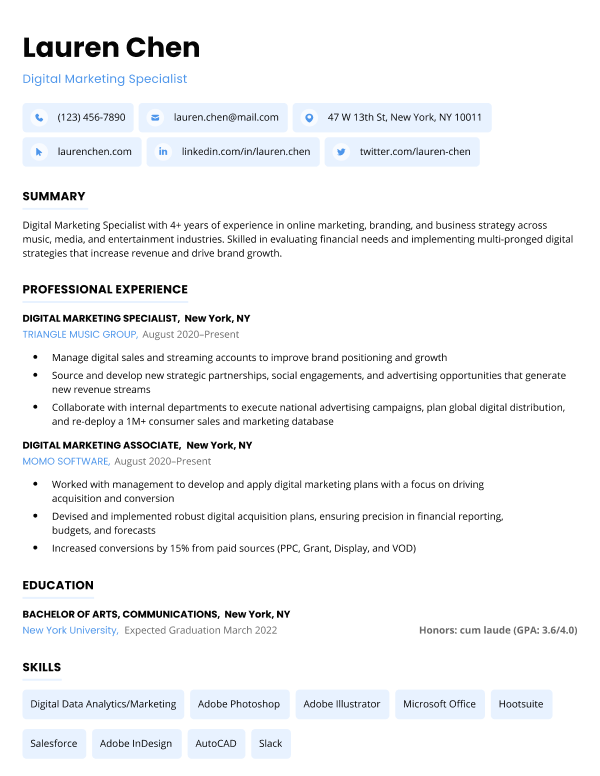To help you create a compelling application, we’ve create a step-by-step guide on how to add publications to your application document the right way.
Our free-to-use resume builder can make you a resume in as little as 5 minutes. Just pick the template you want, and our software will format everything for you.
Publications on a resume vs a CV
If you’re applying to graduate school or an academic position, you’ll be submitting a CV. A CV is a longer document, so you’ll have room for a publications section to show academic committees that you’re qualified to teach or study in your field. All other job applications use a resume.
Including publications on a well-written resume is optional.
When applying for a job, your main goal is to demonstrate to the hiring manager your preparedness for the role, so only list relevant publications on your resume.
For example, if you’re a lawyer applying for a job in contract law, you might wish to list a publication you wrote about contract law.
Unlike with resumes, listing your publications when you write an academic CV is expected.
If you’re applying for an academic role, your CV publications are used to evaluate your depth of knowledge in a particular subject. Unless you lack publications altogether, this section should always be included.
To give a brief overview:
Listing Publications: Resume vs CV
| Resume for a Job | Academic CV |
|---|---|
| Publications are optional | Publications are required |
| Includes only highly relevant publications | Includes all publications necessary to show you're an expert |
| No particular way to format publications | Follows a major style guide (e.g., IEEE, AMA, APA) |
How to put publications on a resume for a job
Your goal when applying for a job with a resume is to keep your publications:
- relevant to the job
- brief
1. Decide where to put your publications
Once you’ve decided to include publications on your resume, the next step is to decide where to put them.
Depending on the number of publications you wish to list, you can use a dedicated publications section, or list your publications within your education section.
This choice is similar to the choice you’d make about how to list your relevant coursework or your certifications on your resume:
- If you have only one or two publications, list them in your education section
- If you have more than two publications, use a dedicated publications section
Most templates you find online don’t have a publications section, so if you go with the second option, you’ll have to add a “Publications” header to the resume template you choose.
2. Choose a format
While there are no strict rules about formatting publications on a resume, consider referencing a popular style guide in your field.
If you’d like to showcase a particular publication, organize your list so that publication comes first.
Whether you choose to use a formal style or an informal one, be consistent with your formatting to show hiring managers that you have good attention to detail.
3. Provide the necessary information
Be sure to include the:
- title of the article, book, or chapter
- name of the journal, website, or conference the publication was featured in
- year it was published
Publications on resume examples
Example in an education section:
Oregon State University, Corvallis, OR – May 2012
B.S. Agricultural Sciences – GPA 3.6/4.0
- “Cows and Climate Change,” American Society of Agricultural Engineers (2016)
- Speaker: “Farmers on the Forefront,” UpSide Agriculture Conference (2013)
Example using a dedicated publications section:
- “Waste in Lean Manufacturing,” chapter from Lean 101, McGraw-Hill, 72–89, July 2019
- “Top 25 Lean Tools to Implement,” Process Pitchfork Magazine, September 2018
- “Value Stream Mapping: What Is it?” SCM House, November 2017
- “Top 13 Procurement KPIs: The Ultimate List” Agile Dojo, January 2017
Here’s what a publication might look like on a resume:

If you still aren’t sure how to format your publication section, try an AI resume builder that can take care of the formatting for you.
How to list publications on a CV for academic roles
Your goal when applying for a position or program with an academic CV is to keep your publications:
- relevant to the position or role
- thorough
If you’re still unsure where to place your publications, check out our video by Career Advisor Corissa as she outlines clear steps for how to include them on your academic CV:
To expand on Corissa’s tips, here are three steps on how to list your publications:
1. Create a dedicated publications section
Having a separate publications section is an important aspect of CV format.
The publications section is most commonly organized in reverse chronological order. While listing publications chronologically is acceptable, starting with the most recent publication at the top ensures that academic committees see that you’re actively involved in your field.
You can also include publications that are in a submitted or pending stage in your CV.
2. Determine which style guide to use
Unlike resumes, CVs require strict adherence to specific style guides because citing sources is a regular requirement in graduate school and research positions.
However, different specialties have different formatting rules. For example:
- medical journals often use AMA
- academic papers written in the humanities field mostly use MLA
- technical papers tend to use the IEEE style guide
Include your CV publications using the proper style guide to demonstrate your knowledge of citation rules.
3. Choose which publications to include
Your publications section should run as long as necessary to communicate how much you know about a subject. Depending on the amount of experience you have, your CV publications section may take up a page or longer.
However, leave out publications that are either obsolete due to newer studies, or publications that are irrelevant to the role you’re applying for.
Publications on CV examples
- Henderson, Matt, and Allen Smith. “Emerging Themes in Dystopian Literature.” Journal of Literary Studies, vol. 90, no.11, 2017, pp. 112-22.
- Nelson P, Chen RS. Asthma epidemiology and risk factors. JAIM. 2020 Jun 8;47(10): 277-289.
- Jones, L. C., & Dillon, K. A. (2011). Deep convection-driven vortex formations on Jupiter and Saturn. International Journal of Astrophysics, 30(2), 13-19.
Here’s how this will look on an finalized academic CV:

Click to rate this article
4.4 Average rating














